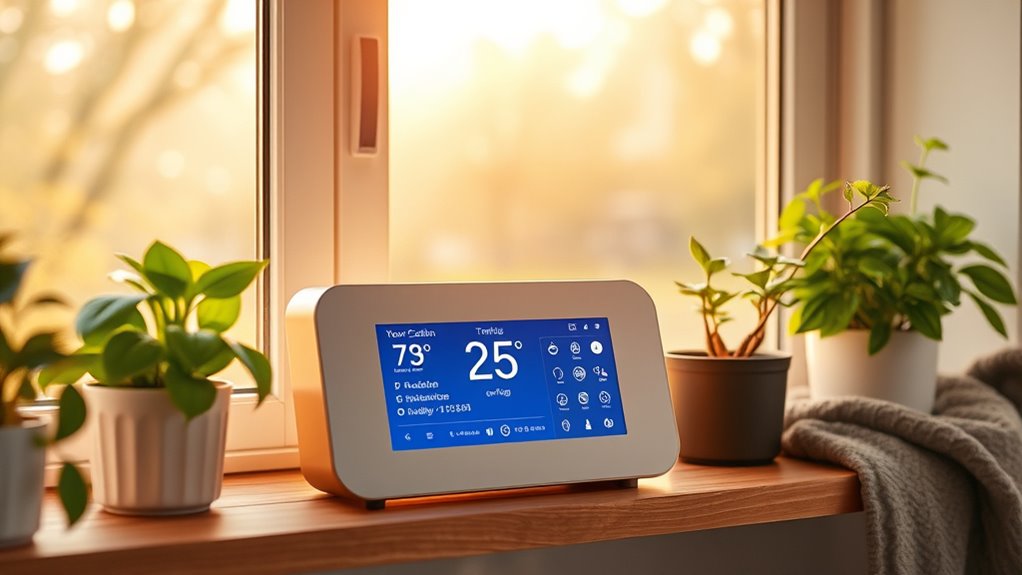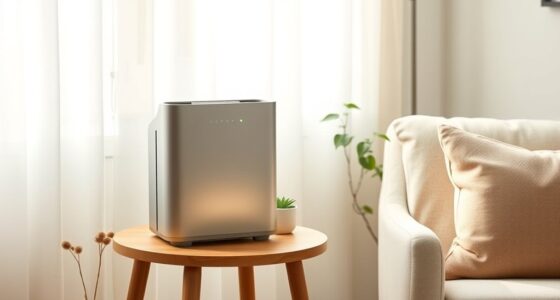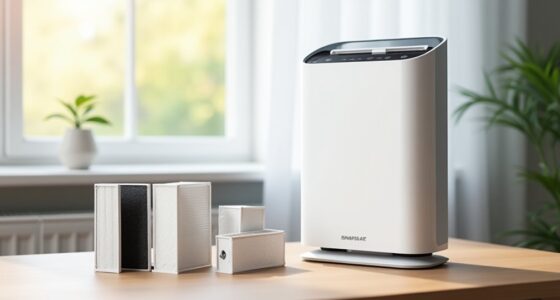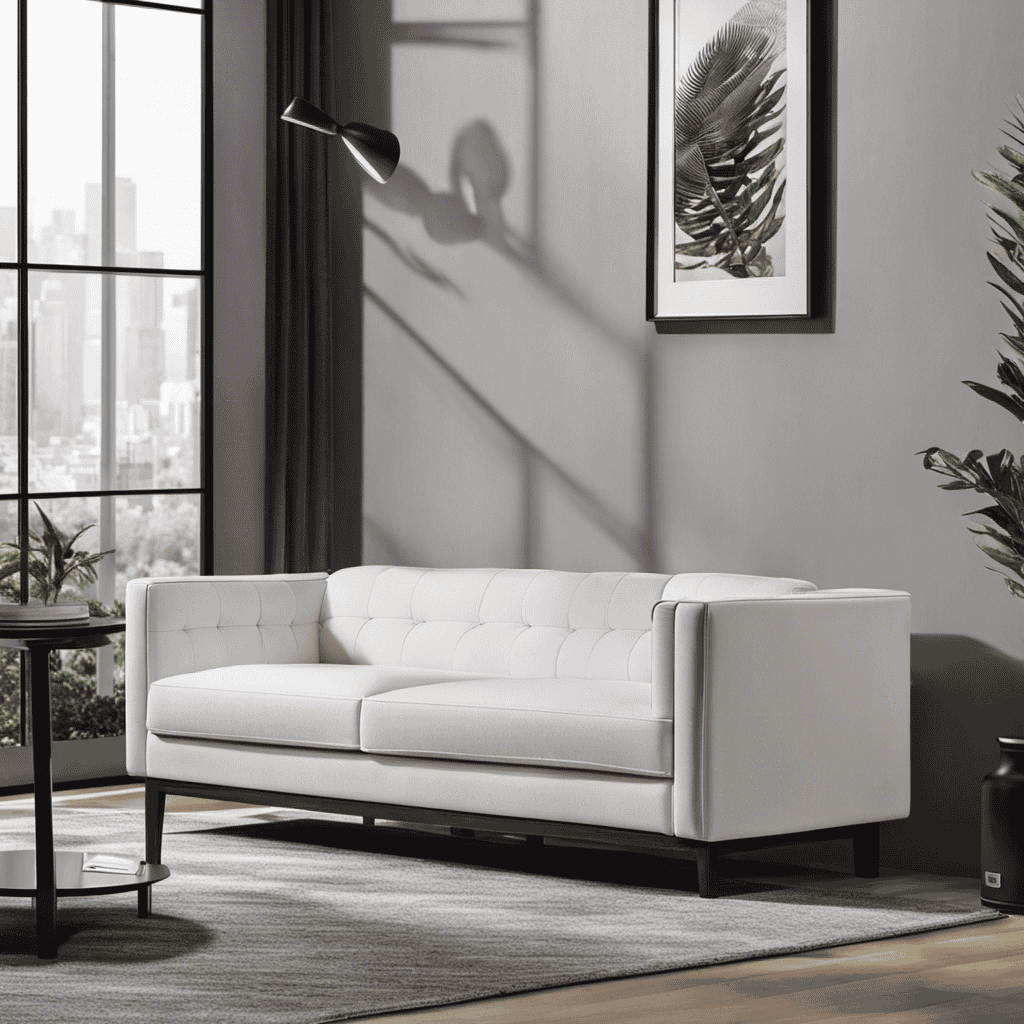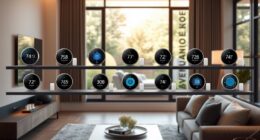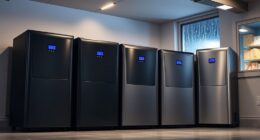If you’re aiming for perfect home comfort in 2025, I recommend the X-Sense WiFi Hygrometer, Raddy WF-120P, and Ambient Weather WS-2000. These stations offer precise measurements, remote monitoring, and customizable alerts, making it easier to manage indoor conditions. They support multiple users and integrate with smart home systems. For a deeper look at each device’s features and how to choose the right one, keep exploring further.
Key Takeaways
- The top devices support Wi-Fi connectivity, remote monitoring, and customizable alerts for personalized indoor climate management.
- They offer precise measurement ranges and calibration features ensuring accurate temperature, humidity, and environmental data.
- Multi-user sharing, data export, and cloud storage enhance long-term tracking and collaborative home comfort.
- Easy setup, compatibility with smart home systems, and mobile app control improve user convenience and accessibility.
- Advanced monitoring features include trend analysis, condition-based alerts, and profiles for tailored indoor climate optimization.
X-Sense WiFi Hygrometer with Base Station and App Monitoring
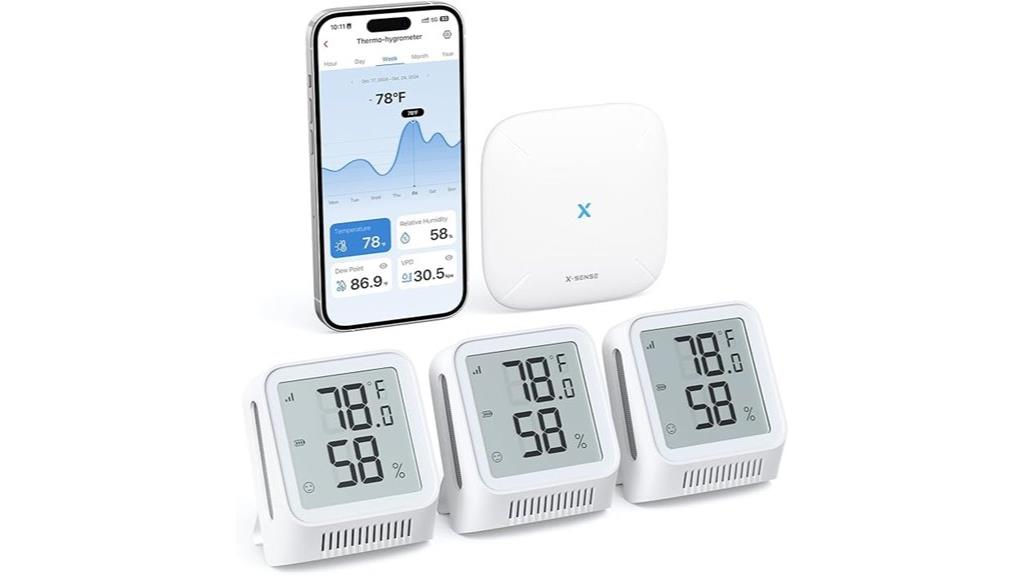
If you’re looking for a reliable indoor climate station that offers precise monitoring and smart alerts, the X-Sense WiFi Hygrometer is an excellent choice. It connects via 2.4 GHz Wi-Fi to the X-Sense Home Security App, with an impressive open-air range of up to 1,700 feet. The Swiss-made sensor provides temperature accuracy within ±0.36°F and humidity within ±2%. You’ll receive real-time notifications for out-of-range conditions, low batteries, and more. The device displays data on a large LCD, and you can monitor trends, set alerts, and share access with up to 12 users—all without subscription fees.
Best For: individuals seeking precise indoor climate monitoring with smart alerts and easy app access for home or plant environment management.
Pros:
- Highly accurate Swiss-made sensor for temperature and humidity readings
- Long-range open-air connectivity up to 1,700 ft, ideal for large or multi-level spaces
- No subscription fees for cloud data storage and sharing access with up to 12 users
Cons:
- Compatible only with 2.4 GHz Wi-Fi, not 5.0 GHz networks
- Requires the base station for app connectivity, adding an extra component to setup
- Limited to indoor use; not suitable for outdoor environmental monitoring
Raddy WF-120P Wi-Fi Weather Station with App Control

The Raddy WF-120P Wi-Fi Weather Station with App Control stands out for its large 10-inch color display, offering an at-a-glance view of all-encompassing indoor and outdoor climate data. It shows temperature, humidity, barometric pressure, wind speed, rainfall, UV index, air quality, moon phase, and a 5-day forecast. The adjustable backlight and night mode ensure easy reading anytime, while low-battery alerts keep it reliable. It updates weather info automatically via Wi-Fi and syncs with the Tuya Smart app, giving access to live data, historical trends, and remote monitoring. With a powerful outdoor sensor, it’s perfect for gardens, farms, or any outdoor space.
Best For: outdoor enthusiasts, gardeners, and homeowners seeking comprehensive real-time weather monitoring and remote data access.
Pros:
- Large 10-inch color display provides clear, comprehensive weather data at a glance.
- Seamless Wi-Fi and app connectivity enable real-time updates, remote monitoring, and historical data analysis.
- High-precision outdoor sensor measures multiple environmental parameters with a 100-meter range, suitable for various outdoor settings.
Cons:
- The device and outdoor sensor may require a stable Wi-Fi connection for optimal performance.
- Setting up and syncing with the Tuya Smart app might be complex for less tech-savvy users.
- The large display may be less portable and more suitable for stationary outdoor or indoor placement.
Ambient Weather WS-2000 Smart Weather Station
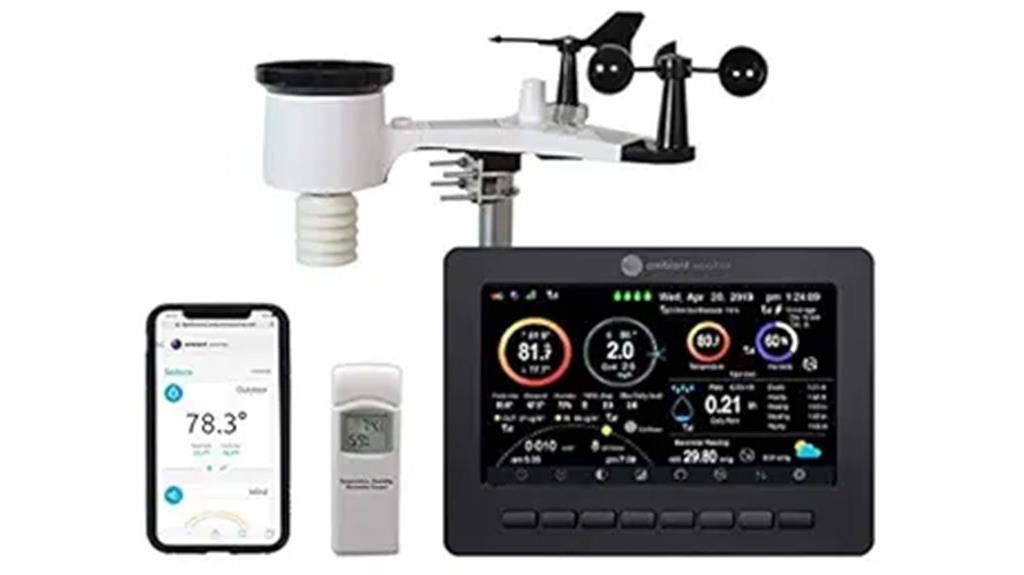
For those seeking an all-encompassing weather monitoring solution, the Ambient Weather WS-2000 Smart Weather Station stands out with its advanced wireless sensor array and vibrant TFT color display. It measures wind speed and direction, temperature, humidity, rainfall, UV, and solar radiation, supporting both imperial and metric units with calibration options. The wireless sensor array provides extensive data, powered by batteries, while the console connects via Wi-Fi, transmitting data to the largest personal weather network. It also offers weather alerts and remote monitoring, making it a versatile choice for home and backyard weather tracking. This station combines accuracy, connectivity, and user-friendly features for total climate awareness.
Best For: home and backyard weather enthusiasts seeking comprehensive, accurate, and connected weather monitoring solutions.
Pros:
- Wireless all-in-one sensor array provides extensive weather data coverage
- Vibrant TFT color display for easy and clear data visualization
- Supports Wi-Fi connectivity for remote monitoring and data sharing
Cons:
- Requires 3 AAA batteries for the sensor array (batteries not included)
- Console needs a 5V DC power adapter, which may need to be purchased separately
- Setup and calibration may be complex for beginners unfamiliar with weather stations
Factors to Consider When Choosing Smart Indoor Climate Stations

When selecting a smart indoor climate station, I look at how well it works with my existing devices and how accurate its readings are. I also consider its connectivity stability and whether I can customize alerts to suit my needs. finally, I check if it offers enough data storage and sharing options to keep track of my climate information over time.
Compatibility With Devices
Choosing a smart indoor climate station requires guaranteeing it works smoothly with your existing devices and network. First, verify it supports your Wi-Fi setup, especially if you rely on 2.4 GHz networks, which are common in many homes. It’s also important to check if the device integrates with your preferred smart home ecosystem like Alexa or Google Assistant, enabling voice control and automation. Make sure the station’s app is compatible with your smartphone’s operating system—whether iOS or Android—and that it’s available on your app store. Additionally, if you want more detailed data, see if it supports external sensors or outdoor units. Compatibility ensures seamless operation, remote monitoring, and effortless integration into your smart home setup, enhancing overall comfort and control.
Accuracy and Precision
Accurate and precise readings are essential when selecting a smart indoor climate station, as they directly impact your ability to maintain ideal comfort and environmental conditions. A reliable device should measure temperature within ±0.36°F (±0.2°C) and humidity within ±2%. High-precision sensors, often from reputable sources like Swiss manufacturers, ensure dependable results, especially for sensitive applications like plant care or health monitoring. Calibration features are valuable because they help maintain sensor accuracy over time by compensating for drift or environmental factors. Additionally, understanding a sensor’s measurement range, such as -4°F to 140°F, guarantees the device performs reliably across typical indoor conditions. Prioritizing accuracy and precision ensures your climate station provides trustworthy data for optimal home comfort.
Connectivity Range and Stability
Reliable data hinges on a stable and wide-reaching Wi-Fi connection, especially since smart indoor climate stations depend on real-time updates to provide accurate readings. A strong signal is vital to prevent data gaps or delays, which can compromise your comfort and device performance. The connectivity range should cover your entire indoor space, ideally at least 1,700 feet in open air, but real-world environments often reduce this. Dual-band Wi-Fi (2.4 GHz and 5.0 GHz) can improve stability, though some devices only support 2.4 GHz, potentially limiting performance. Environmental obstacles like walls, furniture, or interference from electronics can weaken signals and cause disruptions. Regularly optimizing your Wi-Fi setup—such as router placement and signal strength—ensures your climate station stays connected and functions reliably.
Alert Customization Options
When selecting a smart indoor climate station, considering its alert customization options is essential, as these features determine how effectively you can monitor and respond to changing conditions. Many devices let you set personalized alerts for temperature, humidity, dew point, and VPD thresholds, ensuring you’re notified when something’s off. You can usually adjust alert volume, sound, and notification preferences to suit your environment and sensitivity. Some stations allow creating multiple profiles for different rooms or situations, making tailored monitoring easy. Advanced options include setting time-based or condition-based triggers, so alerts happen only when necessary. Notifications can be delivered via smartphone, app pop-ups, or audible alarms on the device itself, giving you flexible ways to stay informed and maintain ideal indoor conditions effortlessly.
Data Storage and Sharing
Choosing a smart indoor climate station with robust data storage and sharing features guarantees you can keep detailed records and readily access your environmental data whenever needed. Look for devices that offer free cloud storage for backup and historical analysis, so you won’t face extra subscription fees. It’s also important that the station allows easy data sharing with multiple users, making it simple for family members or collaborators to monitor conditions. Export options like CSV or PDF are valuable for in-depth review and long-term records. Additionally, ensure the system supports remote access via a mobile app, allowing you to check data anytime, anywhere. Finally, verify that data synchronization is frequent and reliable, ensuring your environmental information remains accurate and up-to-date.
Frequently Asked Questions
How Do Smart Climate Stations Improve Energy Efficiency at Home?
Smart climate stations improve energy efficiency by monitoring indoor conditions and automatically adjusting heating, cooling, and humidity levels. I love how they learn my preferences and optimize settings, reducing wasteful energy use. With real-time data, I can spot inefficiencies and make informed adjustments. This automation not only cuts my energy bills but also helps the environment, making my home more comfortable and eco-friendly without the hassle of manual control.
Can These Devices Integrate With Existing Smart Home Systems?
Yes, these devices can integrate seamlessly with most existing smart home systems. I’ve found that many smart climate stations support popular platforms like Alexa, Google Home, and Apple HomeKit, making it easy to control everything from one app or voice command. This integration allows me to automate temperature and humidity adjustments, creating a more comfortable and energy-efficient environment without the hassle of managing multiple systems separately.
What Is the Typical Lifespan of a Smart Indoor Climate Station?
They say, “A stitch in time saves nine,” and that’s true for smart indoor climate stations. Typically, these devices last about 5 to 10 years, depending on usage and maintenance. I’ve found that regular updates and gentle handling extend their lifespan, helping me keep my home comfy without constantly replacing equipment. Investing in quality models with good warranties also makes a big difference in longevity.
Are There Any Health Benefits Associated With Precise Indoor Climate Control?
Yes, precise indoor climate control can considerably benefit your health. I’ve noticed that maintaining ideal humidity levels reduces allergy symptoms and prevents mold growth. Proper temperature regulation also helps improve sleep quality and boosts overall comfort. By using smart climate stations, I make sure my home stays healthier, safer, and more comfortable, which makes a big difference in my daily well-being. It’s a simple step towards a healthier living environment.
How Secure Is My Data When Using Wi-Fi-Enabled Climate Stations?
I understand your concern about data security with Wi-Fi-enabled climate stations. These devices typically use encryption protocols like WPA2 or WPA3, which protect your data from unauthorized access. However, it is crucial to keep your device firmware updated and use strong, unique passwords. While no system is invulnerable, manufacturers prioritize security, and taking these precautions greatly reduces risks, giving you peace of mind about your home’s data privacy.
Conclusion
Choosing the right smart indoor climate station can genuinely transform your home into a haven of perfect comfort. Whether you pick the X-Sense, Raddy, or Ambient Weather, each offers premium features to keep you in control. Don’t settle for less—your home deserves the best, and these stations are so advanced, they might just make the weather outside seem like child’s play. Invest in one today and enjoy a climate so perfect, it’s almost like magic!
